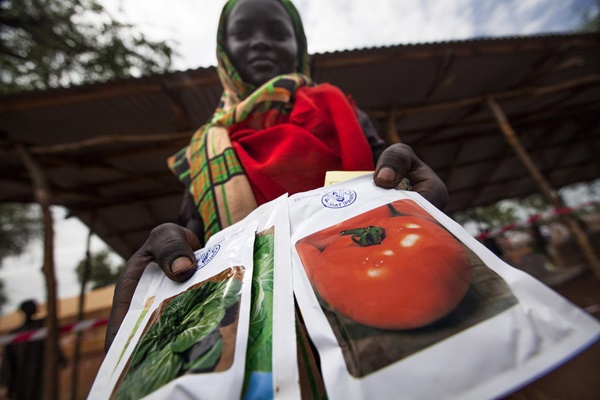
Rome - The world’s farmers must have access to seeds for more productive, nutritious and climate-resilient crop varieties if they are to produce the 50 percent more food needed for a global population predicted to reach ten billion by 2050, the Food and Agriculture Organization of the United Nations (FAO) said today.
“There are no good crops without good seeds. Seeds are the foundation of agri-food systems. We rely on seeds to produce food, feed, fibre, fuel, and they contribute to a friendly environment,” said Director-General QU Dongyu as he opened an FAO-hosted Global Conference on Green Development of Seed Industries.
Raising the quality of seeds “which are resilient to climate stress, improving the use of natural resources, boosting the food and nutrition security, is a great contribution to secure higher crop yields,” economic development and higher incomes for farmers, said Fatma Ben Rejeb, CEO of the Pan-African Farmers Organization, representing smallholder farmers from at least 45 countries. She also highlighted the importance of smallholder farmers’ ancestral knowledge, describing them as “the drivers for agriculture development.”
The two-day Conference brings together a broad spectrum of participants including representatives from civil society, international organizations, FAO Members and the public and private sectors who will bring their perspectives, case studies and priorities to the discussions.
Green and climate-resilient agriculture, supported by innovation to make sure agri-food systems can maintain or increase their benefits while producing lower Green House Gas Emissions, is fundamental for sustainability, QU Dongyu said. He added that it will ensure food security, improve human wellbeing, create opportunities for employment and decent work for all, and protect the planet, now and in the future.
The FAO Director-General said: “The world is facing a global population rise that is expected to reach ten billion by 2050. We need to produce 50 percent more food to adequately feed everyone. The only way to achieve this target is by increasing crop productivity through science and innovation."
The Conference is the third in a series, with the first one held in 1999 in Cambridge, UK, and the second in 2009 at the FAO in Rome. It will focus on four priorities:
Governments are key to eradicating hunger, the FAO Director-General said. They should launch national seed actions to strengthen the seed value chain, and FAO will continue to support them as they develop and implement national policies, regulations and laws to create predictability and foster confidence in seed systems, he added.
Among the senior government representatives taking part in the two-day conference are: US Secretary of Agriculture, Thomas J. Vilsack; Chinese Vice Minister of Agriculture and Rural Affairs, Zhang Taolin; Dutch Vice Minister of Agriculture, Nature and Food Quality, Marije Beens; Argentinian Secretary of Agriculture, Livestock and Fisheries, Jorge Solmi, South African Chief Director Plant Production and Health, Julian Jaftha and Mohamed Soliman, President of Egypt’s Agricultural Research Center.
Participants will share their thoughts and make recommendations for work on the green development of global seed industries, in support of the 2030 Agenda for achieving the Sustainable Development Goals (SDGs).
“With only nine harvests ahead of us before we reach our 2030 agenda, FAO is committed to leverage the momentum generated by this conference to transform the evidence provided into action on the ground,” QU Dongyu said.
FAO’s work
FAO plays a lead role in strengthening the conservation and sustainable use of plant genetic resources for food and agriculture through policy assistance, technical support and awareness raising. Details on FAO work on seeds can be found here.
The organization believes that green and climate-resilient agriculture brings together the climate, resilience, environment and agriculture agendas, triggering action in agri-food systems to respond to the climate crisis.
Examples of FAO’s work in this area, which can be found here, reveal how it can contribute to the achievement of key SDGs targets (in particular, targets under SDGs 1, 2, 10, 12, 13, 14, 15 and 17).